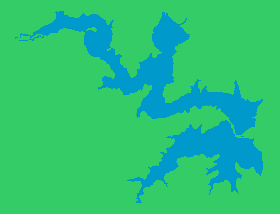Fishing
- Licenses & Regulations
- ShareLunkers
- Fish Identification
- Fish Consumption
- Texas Freshwater Fisheries Center
Water Resources
- Texas Reservoir Levels
- US Army Corps of Engineers
- Texas Water Issues
- Golden Alga
- Aquatic Vegetation
PO Box 1446
Pottsboro, Texas 75076
(903) 786-2389
Dan Bennett, Biologist
Local Information
- Bowie Chamber of
Commerce
(940) 872-1173 or toll-free (866) 872-1173
Nearby State Parks:
Lake Amon G. Carter
Quick Links: Fishing Regulations | Angling Opportunities | Cover & Structure | Tips & Tactics
Lake Characteristics
Location: In Montague County, southwest
of Bowie off Texas 59 or FM 1125
Surface area: 1,848 acres
Maximum depth: 50 feet
Impounded: 1956
Water Conditions
Current Lake Level
Conservation Pool Elevation: 920 ft. msl
Fluctuation: Moderate
Normal Clarity: Moderate
Reservoir Controlling Authority
City of Bowie
304 Lindsay
Bowie, Texas 76230
(940) 872-1114
Aquatic Vegetation
Native emergent vegetation includes water willow. Native submerged vegetation includes bushy pondweed and coontail.
Predominant Fish Species
Lake Records
Stocking History
Latest Survey Report
Lake Maps
An online lake-area map is available on the Chamber of Commerce website.
Fishing Regulations
All species are currently managed under statewide regulations.
Angling Opportunities
| Species | Poor | Fair | Good | Excellent |
|---|---|---|---|---|
| Largemouth Bass | ||||
| Catfish | ||||
| Crappie | ||||
| White Bass | ||||
| Sunfish |
Fishing Cover/Structure
Lake Amon G. Carter is actually two lakes in one. The original lake was constructed in 1956 and has different habitat than the 500-acre extension constructed in 1985. Habitat in the old lake is characterized by rocky shoreline, main lake points, cattail beds, and some standing timber in the upper end. The new lake is characterized by lots of standing timber and some weed beds along the shoreline. Both parts have rip-rap along their respective dams, providing excellent cover for fish. The 20-foot tunnel that joins the two lakes also provides good cover for some fishes.
Tips & Tactics
The best time to catch largemouth bass is in the spring and fall. These are two very different lakes. The old side stays muddy and the fish stay shallow. Start with a pumpkin chartreuse tail worm and white/chartreuse spinner bait. Key on rocky points and boat docks. The new side is normally clear with a lot of brush and timber. If you are looking for a big bite, stay in the new lake and drag a Carolina rig with a june bug or blue fleck worm.
Catfishing is great in June, especially if there is a little runoff from spring rains. Channel catfish like to feed in flowing streams or along windswept shoreline. Use live crawfish in these areas or try drift fishing chicken livers or blood bait across open flats near creek mouths. Channel and flathead catfish can be found almost any time, just about anywhere on this rocky lake. Flatheads like live bait such as bluegill or other sunfish, but channel catfish prefer punchbait.
Crappie are best in the winter/spring when they school tightly for spawning. Jigs and minnows fished around standing timber is a sure bet. Many local anglers target crappie in the old lake which has lots of submerged brush piles, especially around boat houses. Jigs are best with stained water, but get you a bucket of minnows if the water turns muddy. White bass are relative newcomers to this lake. They school at the surface chasing shad in the summer and early fall. Try trolling with a medium diving crankbait that mimics a shad. Sunfish or bream are best in the summer when they congregate around brush, boat houses, or piers. A small hook baited with a live earthworm topped with a sizable cork is a sure fire way to fill your creel with bream. Good eating, too.
